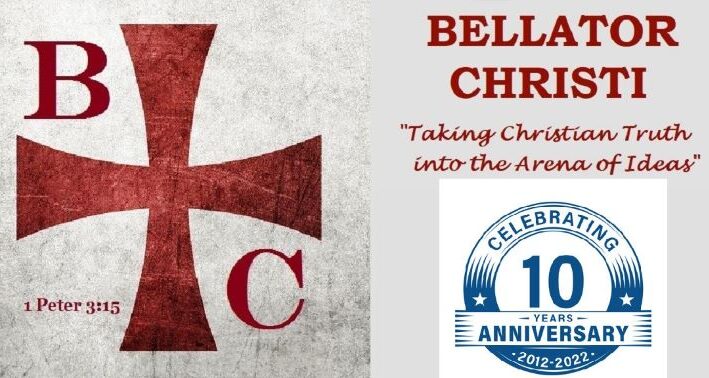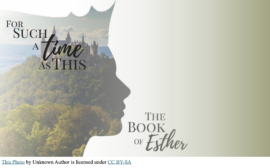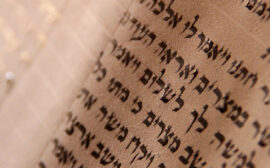By Daniel Merritt | January 16, 2023
In our last article, Understanding Biblical Inspiration – Part I, we examined what Paul meant when he declared that “all scripture is inspired by God” (2 Timothy 3:16 KJV). While the reader can refer to the previous article to refresh their understanding, it was discovered that the very words of the Sacred pages are God-breathed. Inspiration refers to both the OT and NT being God-breathed. Examined were an explanation as to what divine inspiration does not mean, and then a definition as to what inspiration of scripture does mean. Since the Protestant, Catholic, and Eastern Orthodox have the same 27 books, the canonicity of the New Testament was considered first. Also examined were the process and criteria which led to our now 27 NT books receiving canonization. The article concluded that one who picks up a Bible can be assured that the 27 books of the NT are reliable, trustworthy, inspired, and profitable in leading one to salvation. The Bible is sufficient in all matters of faith and practice.
Let us now turn our attention to the OT. The Old Testament consists of a number of books or writings, which were written by different authors at various periods of time. Of the books that comprise the OT, what is the determining factor(s) by which it can be said they are inspired and comprise the OT canon? How did the canonicity of the OT come about? While there is complete agreement among Protestants, Catholics, and Eastern Orthodoxy in regard to the canonicity of the NT, there is disagreement over the number of books in the OT canon.
The Protestant Bible contains 39 OT books. The Catholic Bible contains 46 OT books with seven additional books that are excluded from the Protestant Bible: Tobit, Judith, 1 & 2 Maccabees, Ecclesiasticus, Wisdom of Solomon, and Baruch, and the books of Esther and Daniel have additional chapters which are excluded in Protestant Bibles. These additional books are called the Apocrypha or deuterocanonical. The word Apocrypha means “hidden.” Sometimes the Apocrypha is called “deuterocanonical,” meaning “belonging to a second canon.” Eastern Orthodoxy accepts all of these in addition to extra books for a total of 51 OT books.
Inspired Old Testament Books
The question under consideration is although there is agreement on 39 books of the OT as being inspired, why do Catholic and Eastern Orthodoxy consider the Apocrypha and other additional writings worthy of being in the OT canon?
Jesus and the Scriptures
The OT consists of the Pentateuch, which conservative scholars attribute to Moses, prophetic and historical books written at times roughly contemporaneous with the events when they occurred, and the Writings/Wisdom books. The whole of the OT was completed about 400 BC with the book of Malachi. There is no consensus among scholars as to exactly when the OT canon was fixed. More than a few scholars contend that the OT canon was fixed by the Hasmonean dynasty (140-40 BC), while others argue that it was not fixed until the Council of Jamnia 90 AD or maybe even sometime later. [1] From reading the Four NT Gospels the evidence indicates that by the time of Jesus the canon of the OT had been fixed.
It is clear Jesus and the disciples when speaking of the writings of the OT referred to them as “scriptures” (John 5:39, 7:38; Matthew 21:42). Jesus appealed to the divine authority of the OT during His temptations. He responded to the devil with, “It is written” (Luke 4:1-13). Jesus gave indication of the divine inspiration of the OT when dialoguing with the travelers on the road to Emmaus, as He appealed to “the laws of Moses and the prophets and the psalms” (Lk 24:44), as prophetically speaking of Him of which He was the fulfillment. Many more instances could be cited of Jesus’ view of the revelatory nature of the OT when quoting from it, indicating that He considered the OT to be divinely inspired and authoritative.
Josephus and the Scriptures
Further evidence that the OT was inspired and the canon was fixed before the time of Jesus, comes from the writings of Josephus (37-c.100 AD), a Jewish historian of the first century. The noted historian wrote, “The rabbinical teaching was that the Spirit of God rested on and in the prophets and spoke through them in that their words did not come from themselves; but from the mouth of God and they spoke and wrote in the Holy Spirit.”[2] Josephus continues, “For we have not an innumerable multitude of books among us, disagreeing from and contradicting one another, as the Greeks have, but only twenty-two books [which correspond to our current 39 OT books, see footnote], which contain the records of all the past times; which are justly believed to be divine….”[3] He further writes, “We have given practical proof of our reverence for our own scriptures. For, although such long ages have passed, no one has ventured either to add, or to remove, or to alter a syllable, and it is an instinct with every Jew from the day of his birth to regard them as decrees to God, to abide by them, and if need be, to die for them.” [4]
Three-Fold Division of the Old Testament
It is admitted that there is little historical data explaining the finalization of the OT canon. While there may be a scarcity of details of the actual manner in which the OT writings are viewed as authoritative, one can draw inferences as to the factors affirming OT canonization. W.H. Green writes, “It is argued that the three-fold division of the canon of itself affords a clue to the mode of its formation,” canonization being anchored in the three-fold division of the OT: Law, Prophets, and Writings. [5] F.F. Bruce writes, “A common, and not unreasonable, account of the formation of the Old Testament canon is that it took shape in three stages, corresponding to the three divisions of the Hebrew Bible.”[6] Interestingly, according to Jesus’ words in Luke 24:44, he affirms the three-fold division of the OT when He speaks of the Law of Moses, the Prophets, and the Psalms. This is no doubt equivalent to the threefold division of the OT – the Law, the Prophets, and the Writings.
(1) The preservation of the writings of Moses (Law). We know from historical records that Moses (Deut. 31:9-11, 26), placed his writings by the ark of the covenant. They were placed there not just for preservation, but for reading and obeying. Joshua was to be guided by the very words which Moses placed by the ark (Josh. 1:8). One finds in the historical books of the OT these writings and documents were preserved in the Temple for use throughout the reign of the kings. Among the Jews, there was never any doubt as to the divine inspiration of the Pentateuch. Even in the most degenerate of times, the writings of Moses were regarded as canonical and divinely authoritative.
(2) Prophetic/historical writings by men whom their own contemporaries recognized to be divinely called, the inherent quality of their writings was acknowledged as inspired and accepted. Books such as Joshua, Judges, Samuel, Kings, Isaiah, Jeremiah, Ezekiel, and the Twelve Minor Prophets were written by prophets and therefore received as inspired. Regarding the historical books which were written by a prophet or devout scribe, the scribes who compiled the writings would have been mindful of the author’s historical accuracy or inaccuracies. The fact the scribes did not cast a shadow of doubt on the historical writings attests to their accuracy, the canonical quality of their writings becoming self-evident and acknowledged.
(3) Books known as “Writings,” which contained both moral and spiritual wisdom and insight, were affirmed to be inspired by God. Writings such as Psalms, Proverbs, and Song of Solomon, written by such men as David, Asaph, and Solomon, the Jewish covenant community discerned the innate authenticity of their writings by virtue of divine inspiration. The reception of the Writings into the canon was not merely the acknowledgment of their superior excellence and their uplifting spiritual power, but a recognition of the rightfulness of their claim to be God’s revelation to man.[6] The spiritual profit found in the Writings corresponded with and confirmed the belief in their divine inspiration.
Conclusion
Canonization resting upon this sturdy three-fold prong, the Jewish scribes, and covenant community demonstrated the highest measure of diligence in discerning the revelatory nature of the writings which distinguished themselves as inspired. Books were not made canonical by the act of some public authority, such as a decision rendered in their favor by an assembly of scribes or a general council of any nation. Green writes, “It is not the religious profit derived from these books which led to their admission into the canon, but it is their being inspired of God to guide the faith and practice of the [believer] — in other words, their canonicity— which makes them profitable to the religious life.”[7] They were included in the canon because they were written by men inspired by God for this very purpose. The collection of the canon was simply bringing together into one volume those books whose sacred character had already secured general acknowledgment. It might be added, Christ and the apostles never questioned the authenticity of the OT canon. Since Jesus, the Apostles, and the early church regarded the OT as God’s infallible Word, we have no reason to doubt the authenticity and canonization of the OT.
Having looked at the canonization of the 39 OT books preserved in the Protestant Bible, next time we will turn our attention to answering the question of how did the Apocryphal books become part of some Bibles? Is the Apocryphal inspired and worthy of canonization? If not, why not?
Notes
[1] Paul Enns, The Moody Handbook of Theology, (Chicago: Moody Publishers, 2014), 174-175.
[2] Fritz Rienecker, Linguistic Key to the Greek New Testament, (Grand Rapids, Mich.: Zondervan, 1976), 301.
[3] Josephus, Against Apion, Book 1, Paragraph 8. The 22 books corresponds to the 39 in the Protestant Bible, as joined as one book was Ruth to Judges, Lamentations to Jeremiah, the 12 minor prophets were considered as one book, I and II Samuel, I and II Kings, I and II Chronicles were counted as one book each, and Ezra to Nehemiah were counted as one book, the 22 books mentioned by Josephus (the number of letters in the Hebrew alphabet) equal our present 39 books.
[4] Quoted in Lightfoot, How We Got the Bible, 155.
[5] W. H. Green, General Introduction to the OT: The Canon, (New York: Charles Scribner, 1911), 11-23.
[6] F.F Bruce, The Canon of Scripture, (Inter-Varsity Press, 1988), 36.
[6] Green, The Canon, 33.
[7] Ibid, 31.
About the Author

Dr. Merritt is no stranger to Bellator Christi. He has been featured as a guest contributor on the website for many articles, including one of his biggest hits, “Voltaire’s Prediction: Truth or Myth,” before joining Bellator Christi as a regular contributor. Dr. Merritt received both a Ph.D. and a Th.D. and has studied theology, philosophy, and biblical studies at North-Western Theological Seminary, Southeastern Baptist Theological Seminary, and Campbell University. Dr. Merritt has published such books as Writings on the Ground and Dealing Effectively with Church Conflict. Merritt serves as the Director of Missions for the Surry Baptist Association after serving numerous churches in northwestern North Carolina. He also teaches and directs the Seminary Extension of the Southern Baptist Convention in the Mount Airy, NC area. In his spare time, Merritt serves as a track coach, training the next generation of runners.
More articles by Dr. Merritt:
Copyright Bellator Christi 2023.





